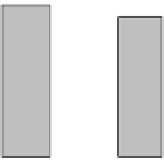Agriculture Reference
In-Depth Information
(a)
10
8
7
6
5
4
3
2
1
0
50u
100u
50u + S
at sowing
Dose of nitrogen (u/ha)
50u + S
50cm
50u + K
at sowing
50u + K
50cm
(b)
40
38
36
34
32
30
50u
100u
50u + S
at sowing
Dose of nitrogen (u/ha)
50u + S
50cm
50u + K
at sowing
50u + K
50cm
14
12
10
8
6
4
2
0
(c)
50u
100u
50u + S
at sowing
Dose of nitrogen (u/ha)
50u + S
50cm
50u + K
at sowing
50u + K
50cm
Fig. 5.15.
Comparison of the effects of adding sulfur or magnesium sulfate (MgSO
4
) at the time of
nitrogen fertilization on hurd yield (a), fibre content (b) and seed yield (c) (FNPC, 2001, 2002; ITC, 2003
(FNPC)). K = MgSO
4
; S = sulfur.
Influence of retting
Influence of applied nitrogen
Increased retting times will facilitate fibre
processing and yield smoother fibres. In all
tests, hemp from fields retted from 5 and 7
weeks was faster to separate and process.
Fields that have been retted for only 1-2 weeks
are always harder to process.
After full flowering, the timing of harvest
does not seem to have a strong influence on
the efficiency of the retting process (as
September is usually dry) or the ease of
processing.
Heavy doses of nitrogen result in stems remain-
ing green longer. This makes fibre separation
more difficult.
Influence of seeding rate
The seeding rate is, together with the length of
retting and the nitrogen dose, one of the most
critical factors affecting the ease of fibre sepa-
ration. At higher densities, stems are thinner
and fibre separation is easy, and vice versa.





















































